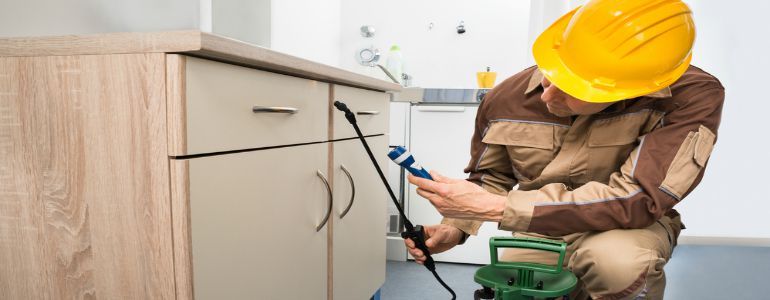Bed Bug Dog Detection: Discover Infestations Early for Comfort!
Expert Insect Control Techniques for Long-Term Outcomes
In the world of pest control, attaining sustained effectiveness and long-term outcomes requires a thorough technique that transcends plain extermination. Expert insect control strategies encapsulate a thorough method that begins with a comprehensive evaluation and analysis, complied with by specific insect recognition to understand their actions patterns. The implementation of Integrated Bug Administration (IPM) principles, combined with eco-conscious therapies, forms the foundation of lasting pest elimination. The true test lies in the recurring monitoring and maintenance of the dealt with areas, making sure a pest-free environment for the near future. By diving into the complexities of these strategies, a much deeper understanding of professional insect control methods for enduring outcomes emerges.
Inspection and Assessment
Upon entering a residential or commercial property for pest control solutions, the first step is a complete inspection and assessment to recognize the degree of the invasion and figure out one of the most efficient treatment strategy. Specialist bug control professionals are educated to thoroughly take a look at the facilities, seeking indicators of bug activity such as droppings, gnaw marks, nests, or any kind of architectural damage. They will additionally examine the conditions that might be drawing in insects, such as food resources, water leakages, or entrance factors.

Insect Identification and Actions

Moreover, recognizing the habits of the identified parasite is essential to implementing reliable control steps. Knowing where insects nest, what they feed on, and their activity patterns can aid pest control experts devise methods to eradicate them successfully.
Integrated Insect Monitoring (IPM)
Integrated Insect Administration (IPM) methods integrate several techniques to manage and prevent bug problems in a sustainable and environmentally pleasant way. Exterminator DC. By incorporating methods such as biological control, environment adjustment, modification of social practices, and making use of immune varieties, IPM aims to lessen using chemical pesticides
One of the essential concepts of IPM is the focus on avoidance. This aggressive approach involves tracking bug populaces routinely to find any kind of potential issues prior to they escalate. By determining bug troubles early on, pest control steps can be carried out promptly and effectively.
In addition, IPM promotes making use of non-toxic Continue insect control techniques whenever possible. This can include utilizing natural killers of the parasites, presenting useful bugs, or utilizing pheromones to interrupt mating patterns. By decreasing reliance on chemical pesticides, IPM not just shields the setting yet additionally assists preserve a balance in the community.
Environmentally-Friendly Treatments
Applying eco-conscious strategies in pest control treatments can properly resolve problems while prioritizing environmental sustainability. Environmentally-friendly treatments focus on decreasing the effect of insect control methods on communities, non-target organisms, and human health. These approaches usually include using natural predators, such as ladybugs or nematodes, to regulate pest populaces, minimizing the need for chemical treatments. Furthermore, techniques like environment see this here adjustment, such as adjusting moisture degrees or eliminating food sources, can aid prevent insects without the use of unsafe compounds.
An additional key element of environmentally-friendly therapies is using natural and naturally degradable items that break down swiftly without leaving harmful deposits in the setting. Botanical pesticides stemmed from plants like chrysanthemums or neem provide reliable pest control while presenting marginal risk to non-target types. Employing methods like heat therapies or pheromone traps can target particular insects with accuracy, reducing the overall ecological influence of insect control methods.
Continuous Monitoring and Maintenance
Consistent monitoring and upkeep are crucial components of efficient pest control management. Ongoing tracking plays a crucial role in making sure that parasite problems are detected early and dealt with promptly. Routine evaluations by qualified professionals are required to determine any type of indications of bug task, examine the efficiency of previous treatments, and make modifications to the insect control plan as needed. By keeping an eye on insect populations in time, pest control experts can track fads, prepare for possible problems, and execute preventative steps to lessen the risk of future infestations.
Along with surveillance, maintenance practices are essential for long-lasting pest control success. This includes implementing proper sanitation actions to remove prospective food and water sources for parasites, sealing entry indicate stop parasites from entering the premises, and addressing any kind of structural problems that could facilitate bug problems (bed bug treatment). By integrating recurring surveillance and upkeep right into an incorporated bug administration method, services can make certain a pest-free setting and safeguard their property versus pricey damages and health and wellness dangers
Conclusion
In conclusion, using expert bug control methods such as complete assessment and evaluation, accurate parasite recognition and understanding of their actions, integrated bug monitoring methods, environmentally-friendly treatments, and recurring surveillance and maintenance are important for achieving lasting results in pest control. By executing these approaches, individuals can effectively take care of bug infestations and maintain a Clicking Here pest-free setting in a sustainable fashion.